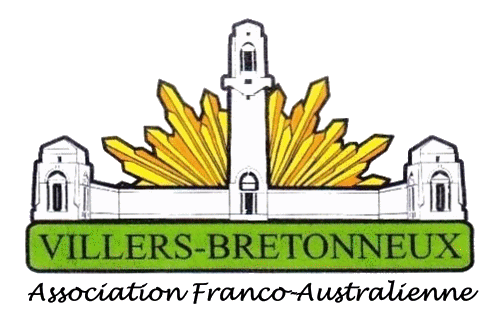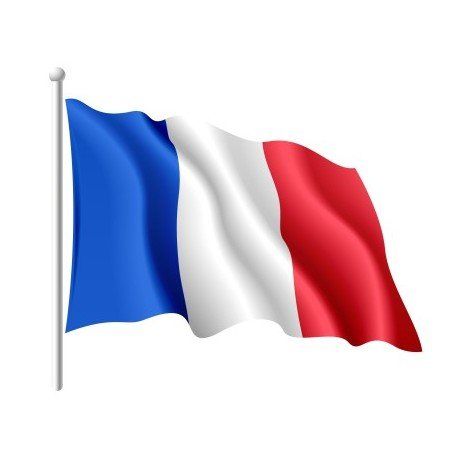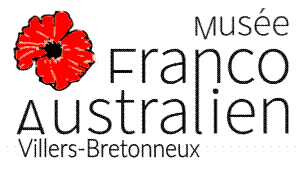
The Franco-Australian Association

Our passion at the service of their Memory ...

EIn 1956, a group of blind Australian veterans wandered through Villers-Bretonneux in search of Victoria School. Glimpsed by Léon Rinet, entrepreneur in the town, he accompanied them and showed them the school
and the Memorial.
and the Memorial.
Noting the total lack of reception facilities for these visitors, Léon Rinet gathered some of his friends to overcome this deficiency and set up a welcoming committee that was to maintain the spirit of gratitude towards these veterans and their families. The declaration of the statutes in Prefecture prefers of June 19th, 1959 (JO of July 4th, 1959).
The first secretary (and also interpreter) was John Harris, whose grandfather, a British soldier, had remained in France after the war and had married a French woman. He had worked at the Imperial War Graves Commission (IWGC) as did his son and grandson John.
The assembled team functioned perfectly and benefited from the recognition of visitors who brought memories of missing persons or documents relating to theaters of operations. Thus, in one of Léon Rinet's rooms, valuable testimonies were presented by visitors in thanks for their welcome. Books were sent to the school library, notably from bread and cheese clubs, the city of Melbourne and the Victoria government. Victoria's London representative Sir William Leggatt released £ 2,000 for the restoration of the school.
In 1964, at the initiative of the committee, panels "Never Forget Australia" are installed in every class of Victoria School.
In 1968, a group of 25 people representing the 3rd division made the pilgrimage of Villers-Bretonneux for the 50th anniversary of the battle. Then on November 11 a detachment of Anzacs defiled in town and laid a wreath at the War Memorial after visiting Victoria School.
In 1970, Australian Prime Minister Bob Hawke donates $ 10,000 to the host committee to put the collections in a dedicated space. He is also offering $ 50,000 to Victoria School for the creation of an additional class.
Over the years, the "treasure" of memories became important and the idea of bringing them together in a unique place was on the mind. In 1974, the hosts of the welcoming committee: Léon Rinet, Marcel Pillon, Marcel Grené, Pierre Huguet, Robert Bled among others decided to create a museum in the attic of Victoria School. A space of 40 m² was set up in the former housing of a teacher and on April 25, 1975, the Anzac Museum was officially inaugurated. It was named William Leggatt Museum, in honor of the representative of the State of Victoria who had helped the Franco-Australian committee to organize this museum. He had appealed for more souvenir and he was relayed by John Philips of Melbourne and Ron Mclean collectors who had come to Villers-Bretonneux the previous year, who sent packages containing uniforms, belts, badges, hats, etc ... to the new museum.
The inauguration took place in the presence of Colonel JR Hall, President of Legacy accompanied by 15 veterans and some 80 people. Among them, Patsy Adam-Smith, author of the book "The Anzacs" become the best-seller of the year and the reference book on the Great War.
The first secretary (and also interpreter) was John Harris, whose grandfather, a British soldier, had remained in France after the war and had married a French woman. He had worked at the Imperial War Graves Commission (IWGC) as did his son and grandson John.
The assembled team functioned perfectly and benefited from the recognition of visitors who brought memories of missing persons or documents relating to theaters of operations. Thus, in one of Léon Rinet's rooms, valuable testimonies were presented by visitors in thanks for their welcome. Books were sent to the school library, notably from bread and cheese clubs, the city of Melbourne and the Victoria government. Victoria's London representative Sir William Leggatt released £ 2,000 for the restoration of the school.
In 1964, at the initiative of the committee, panels "Never Forget Australia" are installed in every class of Victoria School.
In 1968, a group of 25 people representing the 3rd division made the pilgrimage of Villers-Bretonneux for the 50th anniversary of the battle. Then on November 11 a detachment of Anzacs defiled in town and laid a wreath at the War Memorial after visiting Victoria School.
In 1970, Australian Prime Minister Bob Hawke donates $ 10,000 to the host committee to put the collections in a dedicated space. He is also offering $ 50,000 to Victoria School for the creation of an additional class.
Over the years, the "treasure" of memories became important and the idea of bringing them together in a unique place was on the mind. In 1974, the hosts of the welcoming committee: Léon Rinet, Marcel Pillon, Marcel Grené, Pierre Huguet, Robert Bled among others decided to create a museum in the attic of Victoria School. A space of 40 m² was set up in the former housing of a teacher and on April 25, 1975, the Anzac Museum was officially inaugurated. It was named William Leggatt Museum, in honor of the representative of the State of Victoria who had helped the Franco-Australian committee to organize this museum. He had appealed for more souvenir and he was relayed by John Philips of Melbourne and Ron Mclean collectors who had come to Villers-Bretonneux the previous year, who sent packages containing uniforms, belts, badges, hats, etc ... to the new museum.
The inauguration took place in the presence of Colonel JR Hall, President of Legacy accompanied by 15 veterans and some 80 people. Among them, Patsy Adam-Smith, author of the book "The Anzacs" become the best-seller of the year and the reference book on the Great War.
On January 20, 1984, the welcoming committee became the Franco-Australian Association. The new statutes are deposited at the Prefecture of the Somme and Marcel Pillon becomes the President. It was the same year that, at the initiative of Mayor Hubert Lelieur and his deputy Jean-Pierre Coutiez, the twinning principle of Villers-Bretonneux with an Australian city was adopted. The choice, a moment focused on Melbourne, is definitely set on Robinvale whose social and economic configurations are close to those of Villers-Bretonneux. This city, created after the war, took the name of one of its heroes, Robin Cuttle, airman shot near Caix. The symbol is retained by the magistrates of both cities and the matchmaking ceremony will take place on May 4th and 5th in the presence of a large Australian delegation.
The Association is continuing to put in place the numerous objects and documents handed to it by visitors or sent from Australia by the families of the disappeared. In 1988 an agreement was signed between the City Council and the Association for the extension and development of the museum.
The work conducted by Marcel Pillon and funded by the association and the Australian donations opens a new perspective on the many exhibits. Each year, a few thousand visitors discover the facilities held, in turn, by the volunteers of the association.
In 1992, new extension works made it possible to occupy all the attics of the school and to bring the surface to 400 m² with the creation of a video room. Funding is provided by an exceptional grant from the General Council of 300,000 Francs and a grant from the Australian Government of 100,000 Francs. That same year, Marcel Pillon left the association and Jean-Pierre Thierry became president.
The Association is continuing to put in place the numerous objects and documents handed to it by visitors or sent from Australia by the families of the disappeared. In 1988 an agreement was signed between the City Council and the Association for the extension and development of the museum.
The work conducted by Marcel Pillon and funded by the association and the Australian donations opens a new perspective on the many exhibits. Each year, a few thousand visitors discover the facilities held, in turn, by the volunteers of the association.
In 1992, new extension works made it possible to occupy all the attics of the school and to bring the surface to 400 m² with the creation of a video room. Funding is provided by an exceptional grant from the General Council of 300,000 Francs and a grant from the Australian Government of 100,000 Francs. That same year, Marcel Pillon left the association and Jean-Pierre Thierry became president.
Visitors are becoming more numerous and in 1999 the association creates a first job as a receptionist who will be held by Delphine Delohen. In 2003 Melanie Stachowitz will replace her and a second job will be created in 2008 with Lorraine El Yabouri. These new expenses borne by the association will be allowed because of the spectacular increase in the number of visitors. From 2,500 in 2000, there were 10,300 in 2008.
In 2007, on the death of Jean-Pierre Thierry, Annie Brassart took the presidency of the association.
In 2008, a study carried out by the Montaigne firm suggests that a renovation of the museum's structures is necessary to meet the regulation of public access points (elevator, floor, insulation, security). . A financing plan is presented and approved by the municipality: 50% by the Australian government, 24% by the department, 20% by the municipality. The budget is estimated at 700 000 Euros. This project is part of the Australian approach of setting up a memory path.
From 2008 to 2013, renovation projects followed one another, culminating in the definitively adopted Thomas and Tazk cabinet. A closing is necessary and the association must fold its collections in the room Victoria which it will occupy until the reopening of the museum on April 25, 2017.
In 2007, on the death of Jean-Pierre Thierry, Annie Brassart took the presidency of the association.
In 2008, a study carried out by the Montaigne firm suggests that a renovation of the museum's structures is necessary to meet the regulation of public access points (elevator, floor, insulation, security). . A financing plan is presented and approved by the municipality: 50% by the Australian government, 24% by the department, 20% by the municipality. The budget is estimated at 700 000 Euros. This project is part of the Australian approach of setting up a memory path.
From 2008 to 2013, renovation projects followed one another, culminating in the definitively adopted Thomas and Tazk cabinet. A closing is necessary and the association must fold its collections in the room Victoria which it will occupy until the reopening of the museum on April 25, 2017.
The successive presidents of the association were Léon Rinet (1959-1981), Hubert Lelieur (1982), Marcel Pillon (1983-1991), Jean-Pierre Thierry (1992-2007), Annie Brassart (2008), since 2009 the governance is provided by a management board: Etienne Denys, Jean-Pierre Tranchard, Bernard Vaquez from 2009 to 2012, Etienne Denys, Yves Taté, Michel Durand, since 2012.
Written by Yves Taté



